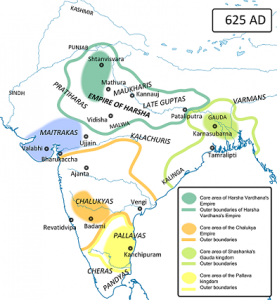The Pallavas emerged as a formidable power in the South around the 4th century AD and were at the height of their power in the seventh century AD. They were able to sustain their rule for about 500 years. They built great cities, centres of learning, temples, and sculptures and influenced a large part of Southeast Asia in culture.
Political History of Pallavas
- The origins of the Pallavas are shrouded in mystery. There are several theories propounded by historians.
- Some historians say they are a branch of the Parthian people (a tribe from Iran) who gradually migrated to South India.
- Some say they are an indigenous dynasty that arose within the Southern region and were a mix of various tribes.
- Some experts believe them to be of Naga origin who first settled around the Tondaimandalam region near Madras.
- Another theory says that they are descendant from a Chola prince and a Naga princess of Manipallavam (an island off Jaffna, Sri Lanka).
- Some others are of the opinion that the Pallavas were feudatories of the Satavahanas.
- The first Pallava kings ruled during the beginning of the 4th century AD. By the 7th century AD, there were three kingdoms in southern India vying for supremacy namely the Chalukyas of Badami, the Pandyas of Madurai and the Pallavas of Kanchipuram.
Extent of the Pallava dynasty
- The Pallava capital was Kanchipuram.
- Their territories at the height of their powers extended from the northern part of Andhra Pradesh to River Kaveri in the South.
- During the seventh century, the Cholas were reduced to a marginal state by the authority of the Pallavas.

- Vatapi (Badami) was occupied by the Pallava king Narasimhavarman who defeated the Chalukyas.
- The Kalabhra uprising was crushed by the Pandyas, Chalukyas and the Pallavas jointly. The Kalabhras were protesting against the numerous land grants (Brahamadeya) to Brahmanas made by the Brahmanic rulers of the three dynasties.
Rulers of the Pallava Empire
Sivaskanda Varman
- Greatest among the early rulers. Ruled at the beginning of the 4th century AD.
- Performed Ashwamedha and other Vedic sacrifices.
Simhavarman/Simhavishnu (Reign: 575 AD – 600 AD)
- Was a Buddhist.
- Included Sri Lanka in his kingdom.
- Defeated the contemporary Tamil ruler. Pallava history assumes a definite character from this ruler onwards.
Mahendravarman (Reign: 600 AD – 630 AD)
- Succeeded Simhavishnu who was his father.
- He was a poet and composed Vichitrachita and Mahavilasa Prahasana.
- He introduced rock-cut temple architecture.
- Was a Jain who converted to Saivism.
- Had on-going rivalry and battles with Pulakesin II of Chalukya dynasty.
- Mahendravarman died in battle with the Chalukyas. He was an able and efficient ruler.
Narasimhavarman I (630 AD – 668 AD)
- Son and successor of Mahendravarman.
- Considered the greatest of the Pallavas. Also called Narasimhavarman Mahamalla/Mamalla.
- Defeated and killed Pulakesin II in 642 AD. He took control of Vatapi, the Chalukya capital and assumed the title ‘Vatapikonda’.
- Also vanquished the Cholas, Cheras and the Pandyas.
- He sent a naval expedition to Sri Lanka and reinstated the Sinhalese Prince Manivarma.
- He founded the city of Mamallapuram or Mahabalipuram which is named after him.
- Hiuen Tsang visited the Pallava kingdom during his reign in about 640 AD and he describes the people living in his kingdom as happy.
- He also says there was an abundance of agricultural products.
- Great Nayannar saints like Appar, Tirugnanasambandar and Siruthondar lived during his reign.
- He was succeeded by his son Mahendravarman II who ruled from 668 to 670 AD.
Later rulers
- After Mahendravarman II, his son Parameswaravarman became the king.
- During his rule, Kanchipuram was occupied by the Chalukyas.
- Nripatunga was an important king who defeated a Pandya king.
- There were a few other rulers. The last ruler of the Pallava dynasty was Aparajitavarman who was killed in battle with the Cholas.
